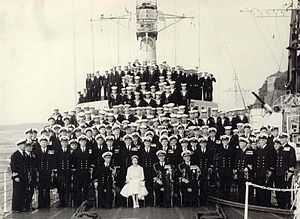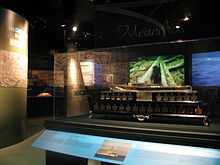HMCS St. Laurent (DDH 205)
 Elizabeth II, Queen of Canada, in her role as Commander-in-Chief of the Canadian Militia and Naval and Air Forces, pictured with the crew of HMCS St. Laurent in Stockholm, Sweden, June 11, 1956. | |
| Career (Canada) | |
|---|---|
| Name: | St. Laurent |
| Namesake: | St. Lawrence River |
| Operator: | Royal Canadian Navy |
| Builder: | Canadian Vickers, Montreal |
| Cost: | $ 15,000,000[1][note 1] |
| Laid down: | 24 November 1950 |
| Launched: | 30 November 1951 |
| Commissioned: | 29 October 1955 |
| Decommissioned: | 14 June 1974 |
| Reclassified: | 4 October 1963 (as DDH) |
| Identification: | pennant number: 205 |
| Honours and awards: | Atlantic 1939-45, Normandy 1944[2] |
| Fate: | Sunk off Cape Hatteras en route to breakers in Texas. |
| General characteristics | |
| Class and type: | St. Laurent-class destroyer |
| Displacement: | As DDE:
2263 tons (normal), 2800 tons (deep load)[note 2] As DDH: 2260 tons (normal), 3051 tons (deep load)[3] |
| Length: | 366 ft (111.6 m) |
| Beam: | 42 ft (12.8 m) |
| Draught: | As DDE: 13 ft (4.0 m)[4] As DDH:14 ft (4.3 m)[3] |
| Propulsion: | 2-shaft English-Electric geared steam turbines, 3 Babcock and Wilcox boilers 30,000 shp |
| Speed: | 28.5 knots (52.8 km/h)[4] |
| Range: | 4,750 nautical miles (8,797.0 km) at 14 knots (25.9 km/h)[5] |
| Complement: | As DDE: 249 As DDH: 213 plus 20 aircrew |
| Sensors and processing systems: | As DDE:
As DDH:
|
| Electronic warfare and decoys: | As DDE:
As DDH:
|
| Armament: | As DDE:
As DDH:
|
| Aircraft carried: | As DDE:
As DDH:
|
HMCS St. Laurent was a St. Laurent-class destroyer that served in the Royal Canadian Navy and later the Canadian Forces from 1955-1974. She was the lead ship of her class,the first modern warship designed and built in Canada.[6]
St. Laurent was laid down on 24 November 1950 by Canadian Vickers at Montreal. She was launched on 30 November the following year and was commissioned into the Royal Canadian Navy on 29 October 1955 and initially carried the pennant number DDE 205 as a destroyer escort.[6] She was reported to have cost $15,000,000 to build.[1] She underwent conversion to a destroyer helicopter escort (DDH) in the early 1960s and was officially re-classed with pennant DDH 205 on 4 October 1963.
Design
The St. Laurent class were built to an operational requirement much like that which produced the British Type 12, and powered by the same machinery plant. The rounded deck-edge forward was adopted to prevent ice forming.[7] The vessels were designed to operate in harsh Canadian conditions. They were built to counter nuclear, biological and chemical attack conditions, which lead to a design with a rounded hull, a continuous main deck, and the addition of a pre-wetting system to wash away contaminants. The living spaces on the ship were part of a "citadel" which could be sealed off from contamination for the crew safety. The ships were sometimes referred to as "Cadillacs" for their relatively luxurious crew compartments; these were also the first Canadian warships to have a bunk for every crew member since previous warship designs had used hammocks.
Armament
As a St. Laurent-class destroyer escort, Saguenay was fitted with twin 3 inch/L50 guns for engaging both surface and air targets. Her anti-submarine armament consisted of a pair of triple barrelled Limbo ASW mortars in a stern well. The stern well had a roller top to close it off from following seas. The design included provision for long-range homing torpedoes, in this case BIDDER [Mk 20E] or the US Mark 35. They were never fitted however.[7]
As built, the twin 3-inch 50-calibre anti-aircraft mounts were installed without shields. These were added in 1963. The gun housings are fibreglass. [note 3]
Machinery
The vessels of the St. Laurent class had two Babcock & Wilcox water tube boilers installed[8] providing 600 PSI (4.1 MPa, 42 kgf/cm²) at 850 °F (454.4 °C).[3]
The steam produced by these boilers was directed at two geared steam turbines which powered two shafts, providing 30,000 HP (22 MW) to drive the ship at a maximum speed of 28.5 knots (52.8 km/h).[9] By the early 1990s, the quoted maximum speed was only 27 kt.[3]
The propelling machinery was of British design. Canadian Vickers supplied the machinery which was manufactured in Canada. The main turbines and machinery were of English Electric design.[9]
Operational history
After commissioning, St. Laurent was sent to the United States to work up and be evaluated and then proceeded to visit the United Kingdom. While there the ship was part of the escort for the royal yacht HMY Britannia on a state visit to Sweden.[10] She was then stationed to the west coast where she performed various diplomatic duties. Prior to undergoing her conversion to a DDH, she was test fitted with the Variable Depth Sonar (VDS).[6]
In 1959 the Canadian government ordered that the St. Laurent class be modernized, even though the class was relatively new. This was predicated on the idea that the St. Laurent class was no longer capable of fighting the new nuclear submarines entering service.[11] This was done to extend the detection range of the ships and to eliminate any speed advantage of the nuclear submarines.[12][13]
In 1962, St. Laurent underwent a conversion to a DDH. This meant extensively rebuilding the superstructure. A hangar and flight deck were added and to make room for these the original single stack was twinned. The flight deck addition required the removal of one gun and one Limbo mount. Also added during the conversion was the VDS, which required the alteration of the stern. She emerged from the refit on 4 October 1963 and was assigned to the east coast.[6]
St. Laurent experienced keel damage later in her career and was paid off early as the Canadian Forces opted to not include her in the Destroyer Life Extension (DELEX) program of the 1970s. She was decommissioned from the Canadian Forces on 14 June 1974 and sat in Halifax as a source for spare parts for her sisters.[6] Her early decommissioning is attributed to manpower shortages in the Canadian Forces at the time.[12]
She was sold in 27 September 1979 to Dartmouth Salvage Co. for scrapping.[14] She was resold and while en route to breakers in Brownsville, Texas, she took on water in the tail end of a hurricane and foundered off Cape Hatteras on 12 January 1980.[12][6]

References
- Notes
- ↑ Adjusted for inflation to 2015 dollars, $147,600,000.
- ↑ These were "officially revised figures" quoted in Jane's Fighting Ships 1963-64
Conways says 2000 tons standard displacement, 2600 deep load.
Combat Fleets of the World 1978-79 says 2390 tons displacement, 2900 full load. - ↑ Jane 's Fighting Ships 1963-64 shows photographs taken in 1962 and 1963 respectively of Skeena and Assiniboine with these.
- Footnotes
- ↑ 1.0 1.1 "Guided Missiles on Escort?". Ottawa Citizen. 18 October 1955. Retrieved 24 June 2014.
- ↑ "Battle Honours". Britain's Navy. Retrieved 24 June 2014.
- ↑ 3.0 3.1 3.2 3.3 Sharpe, Richard (1992). Jane's Fighting Ships 1992-93. Janes Information Group. p. 84. ISBN 0710609833.
- ↑ 4.0 4.1 Raymond V.B. Blackman, ed. (1963). Jane's Fighting Ships 1963-64. London: Sampson Low, Marston & Co. ISBN 0070321612.
- ↑ Couhat, Jean Labayle (1978). Combat Fleets of the World 1978-79: Their Ships, Aircraft and Armament. Naval Institute. ISBN 0870211218.
- ↑ 6.0 6.1 6.2 6.3 6.4 6.5 Macpherson, Ken; Barrie, Ron (2002). The Ships of Canada's Naval Forces, 1910-2002 (3 ed.). St. Catharines: Vanwell Publishing Limited. p. 244. ISBN 1551250721.
- ↑ 7.0 7.1 Friedman, The Postwar Naval Revolution p.161
- ↑ Canadian Navy of Yesterday & Today: St. Laurent class destroyer escort
- ↑ 9.0 9.1 Jane 's Fighting Ships 1963-64, p.34
- ↑ Walker, John (20 April 1956). "Destroyer St. Laurent will join royal escort". Southam News Services (Ottawa Citizen). Retrieved 24 June 2014.
- ↑ Gimblett, Richard H. (2009). The Naval Service of Canada, 1910-2010: The Centennial Story. Dundurn. ISBN 1554884705.
- ↑ 12.0 12.1 12.2 McClearn, Sandy. "St. Laurent Class". hazegray.org. Retrieved 24 June 2014.
- ↑ "Canadian Navy Geared to Fight Fastest Subs". Montreal Gazette. 16 November 1962. Retrieved 24 June 2014.
- ↑ Colledge, J. J.; Warlow, Ben (2006) [1969]. Ships of the Royal Navy: The Complete Record of all Fighting Ships of the Royal Navy (Rev. ed.). London: Chatham Publishing. ISBN 978-1-86176-281-8. OCLC 67375475.
- Sources
- Conway's All the World's Fighting Ships, 1947-1995. US Naval Institute Press. March 1996. ISBN 1557501327.
- Friedman, Norman (1986). The Postwar Naval Revolution. Naval Institute Press. ISBN 0-87021-952-9.
- Jean L. Couhat, ed. (1978). Combat Fleets of the World, 1978-1979: Their Ships, Aircraft and Armament. Arms & Armour Press. ISBN 0853682828.
- Macpherson, Ken; Barrie, Ron. (2002) Warships of Canada's Naval Forces 1910-2002. 3rd Edition. St. Catharines: Vanwell Publishing Limtied. ISBN 1-55125-072-1
- Raymond V.B. Blackman, ed. (1963). Jane's Fighting Ships, 1963-1964. London: Sampson Low, Marston & Co. Ltd. ISBN 0070321612.
- Richard Sharpe, ed. (May 1992). Jane's Fighting Ships, 1992-1993 (95 ed.). Jane's Information Group. ISBN 0710609833.
External links
| Wikimedia Commons has media related to HMCS St. Laurent (DDH 205). |
| ||||||||||||||